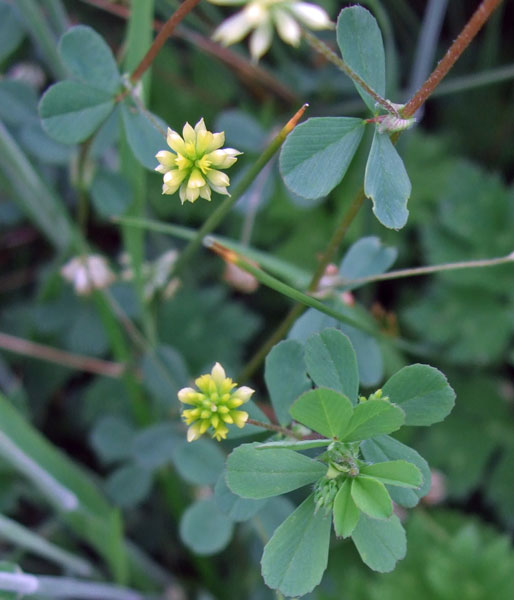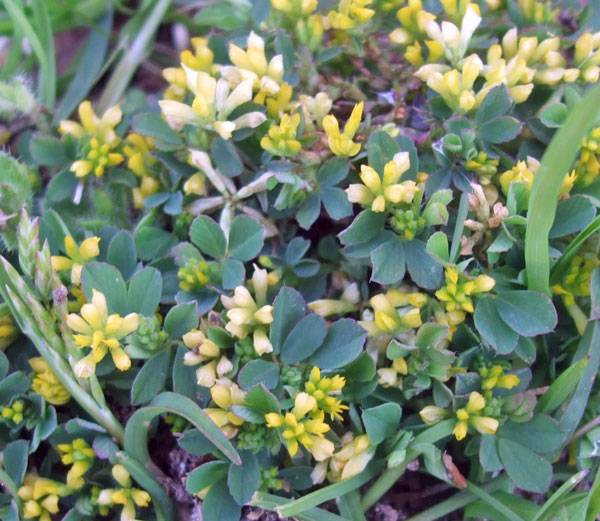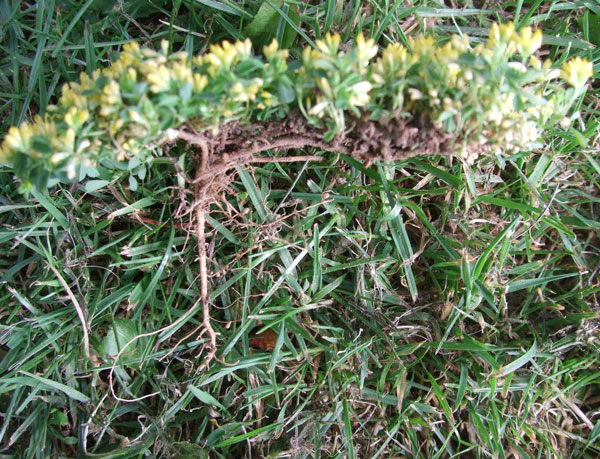 Botanical name: Trifolium dubium
Botanical name: Trifolium dubium
Family: Fabaceae
General information
Lesser trefoil is an annual turf weed that is related to the clover family of Fabaceae (also part of the pea family). In fact this weed is often referred to as yellow suckling clover and like other clovers it is able to fix nitrogen from the atmosphere.
It is a major nuisance in all types of managed turf and lawns as it can easily tolerate a low cutting height. It is also found on grassland and waste areas where it is left undisturbed and is capable of growing over 30 cm high.
Lesser trefoil spreads by creeping runners and seed, it anchors itself into the soil with a deep tap root, which enables it to withstand drought conditions. It is often confused with black medic, as the leaves and flowers have a very similar appearance (the leaf tips of black medic are sometimes pointed, where lesser trefoil are not).
Lesser trefoil will grow in most soil types, but thrives on nutrient deficient, non-acidic, free draining soils, typical of dry, sandy root zones. Once established it can spread aggressively, as it forms into large patches, eventually choking and suffocating the grass.
Lesser Trefoil Identification
- Leaves: The leaves are similar to those of white clover, only smaller. They typically measure between 5 – 12 mm long and 3 – 7 mm wide. Each leaf consists of three leaflets (trifoliate) borne on short stalks, with the centre leaflet on a slightly longer stalk. Although it is difficult to see, the leaves are actually slightly toothed.
- Flowers: The small flowers of lesser trefoil are bright yellow initially, turning brown later in the season. They are produced in clusters and are approximately 12 mm across. The flowering period is between May and September.
- Roots: Lesser trefoil has a deep penetrating taproot (see image below).
Lesser Trefoil Images (click to enlarge image)
More images and free downloads of lesser trefoil
Prevention and control of lesser trefoil
Ensure the turf is kept in optimum condition with good turf care practices to prevent thin and weak areas of grass, which allow weeds to invade the lawn.
Raking lesser trefoil into an upright position, prior to mowing the lawn will help remove sections of the weed and eventually weaken it.
Regular mowing will help prevent and remove the seed heads. As lesser trefoil is an annual weed, reducing the amount of seed heads will prevent in resurfacing in subsequent years.
Using a grubber, pocket knife or small hand fork this turf weed can be removed, taking care to remove the whole plant.
Individual patches and large infestations of this weed can be treated using a selective herbicide. Although it is a little more difficult to control than white clover, it can still be killed with a single application, especially with the professional turf care weed killers.
Although numerous chemicals can be used to control trefoil, the most effective products contain mecoprop-p, which is very effective against weeds in the clover family.
Recommended chemicals for lesser trefoil control
2,4-D + Mecoprop-p
Fluroxypyr + Clopyralid
Fluroxypyr + Mecoprop-p
Dicamba + Mecoprop-p
Recommended products for lesser trefoil control
Professional products (The user requires the appropriate certificate/s to apply these products)
Headland Relay Turf (Mecoprop-p, Dicamba, MCPA)
React Ultra (Mecoprop-p, Dicamba, MCPA)
Everris Praxys (Clopyralid, Fluroxypyr, Fluosulam)
Bayer Longbow (Mecoprop-p, Dicamba, MCPA)
Barclay Holster XL (2,4-D, Fluroxypyr, Dicamba)
Mascot Greenor (Clopyralid, Fluroxypyr, MCPA)
Vitax Esteem (2,4-D, Clopyralid, MCPA)
Products available for non-professional use (These products are available from garden centres and DIY stores)
Verdone extra (Clopyralid, Fluroxypyr, MCPA)
Resolva lawn weed killer (2,4-D, Mecoprop-p, MCPA, Dicamba)
Doff lawn spot weeder (2,4-D, Mecoprop-p, Dichlorprop-p)
Vitax Lawn Clear (2,4-D, Clopyralid, MCPA)
Weedol lawn weed killer (Clopyralid, Fluroxypyr, MCPA)





